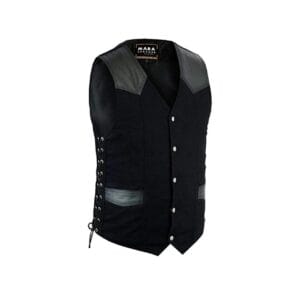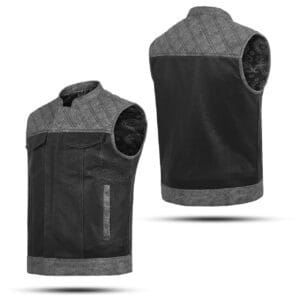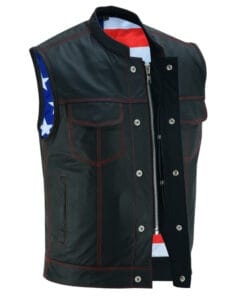The Mysterious “13” on a Biker Vest: Decoding the Badge of Rebellion
Picture this: You’re cruising down a sun-soaked highway, the rumble of motorcycles filling the air. A group of bikers roars past, their leather vests adorned with various patches and symbols. Among the skull-and-crossbones and eagle emblems, you spot a simple yet intriguing number: 13. What’s the deal with that? Why would someone proudly display on their biker vest, what’s often considered an unlucky number? Well, buckle up (or rather, rev up), because we’re about to dive into the fascinating world of biker culture and unravel the mystery behind the notorious “13” patch.
The Basics: Biker Vests 101
Before we crack the code of 13, let’s talk about the canvas it’s displayed on – the biker vest. These aren’t your run-of-the-mill fashion statements. Nope, a biker vest is like a wearable resume, telling the story of who they are, where they’ve been, and what they stand for.
Typically made of tough, weather-beaten leather, these vests (often called “cuts”) are more than just protection from the elements. They’re a biker’s second skin, earning their character through miles of open road, late-night rides, and countless adventures. Over time, these vests become a patchwork of memories, affiliations, and personal philosophies.
The back of the biker vest is prime real estate, usually reserved for the most important insignias in the form of patches – like a motorcycle club’s logo or that enigmatic “13”. The front and sides? That’s where you’ll find an assortment of smaller patches, pins, and trinkets, each with its own significance in the biker world.
Men’s Classic Western Cut Motorcycle Leather Vest
Unlucky for Some, Lucky for Others: The Number 13
Now, onto the star of our show – the number 13. In many cultures, 13 is considered unlucky. It’s why some buildings skip the 13th floor, and why your great-aunt Mildred refuses to leave the house on Friday the 13th. But in the biker world? It’s a different story altogether.
For bikers, 13 is a badge of honor, a middle finger to societal norms, and a nod to the rebellious spirit that’s at the heart of motorcycle culture. But where did this association come from? Strap on your helmet, because we’re taking a ride through history.
The Origins: Alphabets and Outlaws
The use of “13” in biker culture is often traced back to the letters “M” and “C” – the 13th and 3rd letters of the alphabet, respectively. “MC” stands for “Motorcycle Club,” a term that gained prominence in the 1940s and 50s as motorcycle groups began to organize and form their own subculture.
However, the number 13 took on an additional, more defiant meaning in the 1960s. This was when the American Motorcyclist Association (AMA) allegedly stated that 99% of motorcyclists were law-abiding citizens, and only 1% were outlaws causing trouble. Whether this statement was ever actually made is up for debate, but it didn’t matter – the idea stuck.
In response, some motorcycle clubs embraced the “1%” label, wearing it as a badge of pride. They saw themselves as the rebellious few, living life on their own terms outside of society’s rigid rules. And thus, the “13” patch became a not-so-subtle nod to this outlaw status.
Black Denim Adjustable Motorcycle Vest W/Leather Accents
Breaking it Down: What Does “13” Really Mean?
So, when you see a “13” patch on a biker’s vest, what exactly is it saying? Well, it’s not just one thing – like many symbols in subcultures, its meaning can be multifaceted:
- Rebellion and Non-Conformity: At its core, the “13” is a statement of individuality. It says, “I don’t play by society’s rules. I make my own.”
- Motorcycle Club Affiliation: For some, it’s simply a proud declaration of being part of the MC world.
- Outlaw Status: In certain circles, it can indicate membership in or support of “1%” clubs – those that embrace the outlaw image.
- Superstition Defiance: By embracing a number often considered unlucky, bikers show they’re not afraid to challenge conventional wisdom.
- Brotherhood: The “13” can represent unity among bikers who see themselves as outsiders in mainstream society.
It’s worth noting that not all bikers or motorcycle clubs use or endorse the “13” symbol. Like any subculture, the biker world is diverse, with different groups having their own traditions and symbols.
The Controversy: More Than Just a Number
Now, let’s address the elephant in the room – or should I say, the hog in the garage? The “13” patch, especially when associated with the “1%” concept, has been a source of controversy and misconceptions.
Law enforcement agencies have often viewed the “13” and “1%” symbols as indicators of criminal activity. This perception has been fueled by high-profile cases involving certain motorcycle clubs engaged in illegal activities. However, it’s crucial to understand that wearing a “13” patch doesn’t automatically make someone a criminal, just as not all motorcycle clubs are involved in illegal activities.
Many bikers argue that the “13” is more about a state of mind – a commitment to freedom, brotherhood, and living life on one’s own terms. They emphasize that it’s possible to be a “13” or “1%” without breaking the law, focusing instead on the aspects of biker culture that revolve around camaraderie, charity rides, and a shared passion for motorcycles.
Men’s Honeycomb Stitch Cowhide Leather Vest
The Evolution of “13”: From Rebellion to Tradition
As with many symbols, the meaning of “13” in biker culture has evolved over time. What started as a rebellious statement has, for many, become a cherished tradition. Today, you might see the “13” patch on the vests of bikers who have never had a run-in with the law but deeply respect the history and ethos of motorcycle culture.
Some modern interpretations of the “13” symbol focus more on its positive aspects:
- A commitment to the freedom of the open road
- Loyalty to one’s fellow riders
- A reminder to live life to the fullest
- A symbol of the tight-knit biker community
In this light, the “13” becomes less about being an outlaw and more about being part of a unique brotherhood (or sisterhood – let’s not forget the growing number of women in the biker world).
Beyond the Patch: “13” in Biker Culture
The influence of “13” extends beyond just patches on denim vests. You might spot it tattooed on a biker’s arm, emblazoned on motorcycle parts, or even worked into custom bike designs. Some bikers have embraced the number in other aspects of their lives – maybe planning rides on the 13th of the month or considering 13 their lucky number.
There are even stories of bikers deliberately seeking out hotel rooms or parking spaces numbered 13, turning the superstition on its head. It’s as if by embracing what others fear, they’re reaffirming their identity as free-spirited rebels.
Diamond Stitch Black Suede Leather Motorcycle Vest
The Bigger Picture: Symbols and Identity
The “13” patch is just one small piece in the rich tapestry of biker symbolism. From the iconic skull-and-crossbones to the “Live to Ride, Ride to Live” motto, these symbols serve as a visual language, instantly recognizable to those in the know.
These patches, pins, and emblems aren’t just decoration – they’re a way for bikers to express their identity, affiliations, and beliefs. In a world where conformity often feels like the norm, the biker vest becomes a canvas for individual expression, with each symbol telling part of the wearer’s story.
The Power of Perception
It’s fascinating how a simple number can carry so much weight. To the uninitiated, a “13” patch might seem odd or even ominous. But to those within the biker community, it’s loaded with meaning, history, and a touch of defiance.
This disconnect in perception highlights a broader truth about subcultures – symbols that seem strange or threatening to outsiders often have deep, nuanced meanings for insiders. It’s a reminder that we shouldn’t judge a book by its cover, or in this case, a biker by their patches.
Men’s SOA Leather Biker Vest W/ USA Flag Lining
Riding into the Future
As motorcycle culture continues to evolve, so too does the meaning of its symbols. Younger riders might wear a “13” patch as a nod to tradition rather than a declaration of outlaw status. And with the rising popularity of motorcycle clubs focused on charity work or specific professions (like firefighters or veterans), the interpretation of “13” continues to diversify.
One thing’s for sure – whether you see it as a sign of rebellion, a mark of brotherhood, or simply a cool piece of biker lore, the “13” patch isn’t going anywhere. It’s etched into the history of motorcycle culture, a small but powerful symbol of the freedom and individuality that draws so many to the open road.
So, the next time you see a biker sporting a “13” on their well-worn leather biker vest, you’ll know there’s more to the story than just a number. It’s a glimpse into a world where the journey matters more than the destination, where brotherhood is forged on the open road, and where sometimes, being a little bit unlucky is the luckiest thing of all.
Remember, whether you’re a hardcore biker or just someone curious about the culture, there’s always more to learn. The world of motorcycles is as vast and varied as the roads they travel. So why not strike up a conversation with a biker sometime? You might be surprised at the stories behind their patches – and who knows, you might just find yourself itching to hit the open road yourself.
Just don’t forget your leather vest. And hey, maybe leave a little space for a “13” of your own.





